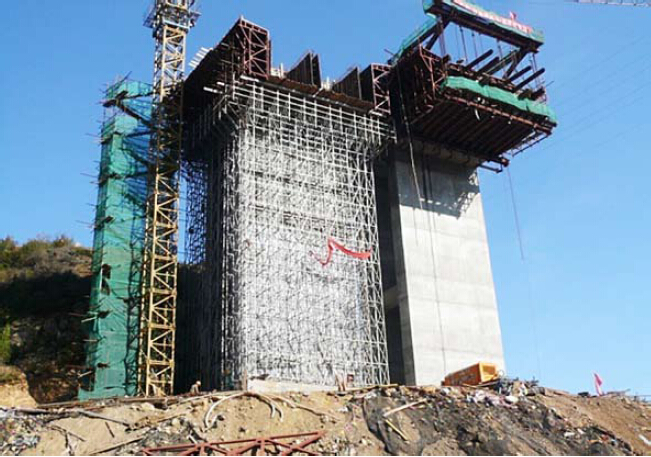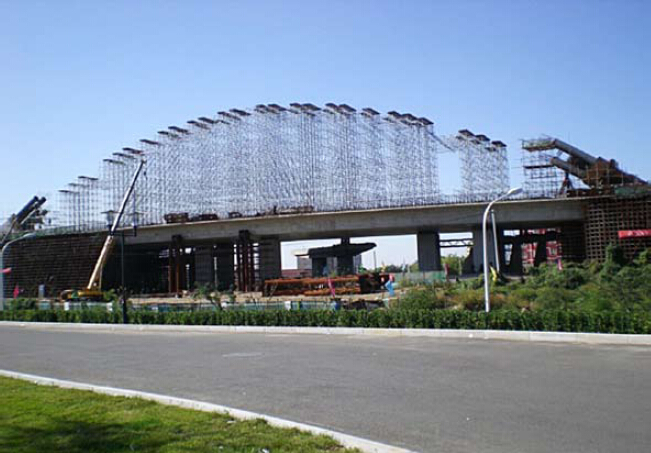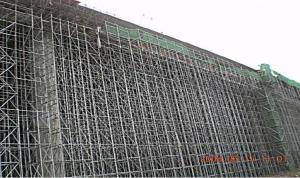Tower-scaffolding for formwork and scaffolding systems
- Loading Port:
- Tianjin
- Payment Terms:
- TT OR LC
- Min Order Qty:
- 50 m²
- Supply Capability:
- 1000 m²/month
OKorder Service Pledge
Quality Product, Order Online Tracking, Timely Delivery
OKorder Financial Service
Credit Rating, Credit Services, Credit Purchasing
You Might Also Like
Tower Scaffolding
Shoring tower is an effective supporting system. It is easy to assemble and dismantlement, and
has excellent stability and bearing capacity. It has been widely used in the construction of industry
& residential buildings , bridges, tunnels and dam project, etc.
Characteristics:
◆ High degree of standardization.
◆ Easy storage and transportation


- Q:How does steel formwork contribute to the sustainability of a construction project?
- Steel formwork contributes to the sustainability of a construction project in several ways. Firstly, steel formwork is highly durable and has a long lifespan. This means that it can be used for multiple construction projects, reducing the need for new formwork and minimizing waste. Additionally, the durability of steel formwork reduces the need for frequent repairs or replacements, saving both time and resources. Secondly, steel formwork is a reusable material. It can be easily disassembled and reassembled for use in different projects, reducing the demand for new formwork and minimizing the amount of waste generated. This significantly reduces the environmental impact of construction projects, as it reduces the need for new materials and decreases the amount of waste sent to landfills. Furthermore, steel formwork is highly efficient and allows for faster construction times. Its strength and stability enable the construction process to progress more quickly, reducing the overall duration of the project. This not only saves time but also reduces the energy consumption associated with construction activities, contributing to the overall sustainability of the project. Moreover, steel formwork is a recyclable material. At the end of its lifespan, the steel formwork can be recycled, further reducing its environmental impact. Recycling steel requires less energy and resources compared to manufacturing new steel, thus reducing greenhouse gas emissions and conserving natural resources. In summary, steel formwork contributes to the sustainability of a construction project by being durable, reusable, efficient, and recyclable. It reduces the need for new formwork, minimizes waste generation, saves construction time, and conserves resources. By incorporating steel formwork into construction projects, builders can significantly reduce the environmental impact while ensuring long-term durability and efficiency.
- Q:Can steel formwork be used for both above-grade and below-grade walls?
- Yes, steel formwork can be used for both above-grade and below-grade walls. Steel formwork is highly versatile and can be used in various construction applications, including both above-grade and below-grade walls. Its strength and durability make it suitable for withstanding the pressure and weight of the concrete used in these walls. Additionally, steel formwork can be easily assembled and disassembled, allowing for efficient construction processes for both types of walls. Whether it is for basement walls or exterior walls above ground, steel formwork can provide the necessary support and shape for the concrete to be poured, resulting in strong and long-lasting structures.
- Q:How is steel formwork supported during concrete pouring?
- Steel formwork is supported during concrete pouring by using props or scaffolding. These supports are strategically placed at regular intervals to provide stability and prevent any sagging or movement of the formwork. Additionally, adjustable bolts or wedges are used to ensure that the formwork remains level and in the desired position throughout the pouring process.
- Q:Can steel formwork be used for theater construction projects?
- The utilization of steel formwork is applicable to theater construction projects. Steel formwork is composed of temporary or permanent molds constructed from steel, which are employed to mold and support concrete during the construction phase. It is a highly adaptable and long-lasting material that can be utilized for various construction endeavors, including theater construction. The utilization of steel formwork presents several advantages for theater construction projects. Firstly, it provides a considerable amount of strength and stability, guaranteeing that the concrete structures created for theaters are robust and durable. This is of utmost importance in theaters, where safety is a primary concern due to the large gatherings of individuals in these spaces. Furthermore, steel formwork permits the achievement of intricate and complex designs, which are often necessary for theater construction. The malleability of steel formwork enables the creation of personalized shapes, curves, and patterns, enabling architects and designers to bring their innovative visions to fruition. Additionally, steel formwork is reusable, thus making it a cost-effective option for theater construction projects. In contrast to traditional wooden formwork, which must be replaced after a single use, steel formwork can be employed multiple times, resulting in reduced material and labor expenses. Lastly, steel formwork facilitates a faster construction process. Its simple assembly and disassembly hasten the construction timeline, allowing theater projects to be completed within a shorter timeframe. In conclusion, steel formwork is a suitable selection for theater construction projects due to its strength, adaptability, flexibility, reusability, and efficiency. It offers numerous benefits that contribute to the successful and timely completion of theater construction projects.
- Q:How does steel formwork prevent concrete spalling?
- Steel formwork prevents concrete spalling by providing a strong and durable mold for the concrete to be poured into. The steel formwork holds the concrete in place during the curing process, preventing any movement or displacement that could lead to spalling. Additionally, the smooth surface of the steel formwork helps to create a uniform and even finish on the concrete, minimizing the risk of spalling.
- Q:What are the different types of edge protection used with steel formwork?
- To ensure safety and prevent accidents on construction sites, various types of edge protection are utilized with steel formwork. Here are some commonly used options: 1. Edge protection barriers: These sturdy barriers, typically constructed from materials like steel or aluminum, are installed along the formwork's edges. Their purpose is to physically obstruct workers from unintentionally falling off. These barriers are adjustable, making them easy to install and remove as needed. 2. Toe boards: Usually made of wood or steel, toe boards are positioned along the lower edge of the formwork. Their role is to act as a barrier, preventing tools, equipment, or debris from falling off. Additionally, they serve as a visual reminder for workers to exercise caution near the edge. 3. Handrails: Attached to vertical posts, handrails are horizontal bars placed along the formwork's edges. They offer workers a secure grip, aiding in balance and stability, especially when working at elevated heights. Safety regulations often mandate the installation of handrails in specific situations. 4. Safety nets: These nets are positioned beneath the formwork to catch any falling objects or debris. Typically crafted from robust mesh material, safety nets are designed to absorb the impact of such items. They prove especially beneficial during activities where there is a risk of objects falling off, such as concrete pouring or formwork removal. 5. Harnesses and lifelines: In high-risk scenarios, workers may be required to wear harnesses and employ lifelines to safeguard against falls. These systems consist of a harness worn by the worker, which is connected to a securely anchored lifeline. Harnesses and lifelines provide an additional layer of protection when edge protection alone may not suffice. It is important to consider project-specific requirements, local regulations, and the level of risk involved when selecting edge protection measures. Construction companies must thoroughly assess site conditions and implement appropriate measures to ensure worker safety.
- Q:What are the different types of lifting systems used with steel formwork?
- Steel formwork in construction projects can be transported and installed using various types of lifting systems. These systems aim to facilitate the process and are as follows: 1. Crane lifting system: The most commonly used system involves cranes equipped with hooks or specialized attachments to lift and move the steel formwork panels. Cranes are ideal for large-scale projects due to their strength and stability. 2. Forklift lifting system: Alternatively, forklifts equipped with forks can slide under the formwork and lift it off the ground. This option is suitable for smaller sites or areas with limited space. 3. Hydraulic lifting system: Hydraulic systems, integrated into the formwork itself, use hydraulic power to lift and move the panels. These systems are known for their precision and user-friendly nature. 4. Manual lifting system: In certain cases, manual labor is employed to lift and move the formwork panels. This method involves a team of workers using ropes, chains, or other tools to hoist the formwork into position. Manual lifting is typically used for smaller panels or when other systems are unavailable. 5. Self-climbing lifting system: High-rise projects often utilize self-climbing systems. These systems lift and move the formwork vertically as construction progresses, employing hydraulic or mechanical mechanisms for efficiency. 6. Tower crane lifting system: Tower cranes, commonly found in large construction projects, can lift and move formwork panels to various heights and locations on the site. Their reach and versatility make them suitable for projects with complex formwork requirements. Ultimately, the choice of lifting system depends on factors such as panel size and weight, site characteristics, and project requirements. It is crucial to select the appropriate system to ensure the safe and efficient installation of steel formwork.
- Q:What are the different sizes and dimensions of steel formwork panels?
- Different construction needs are catered to by steel formwork panels that come in various sizes and dimensions. The manufacturer and specific project requirements determine the sizes and dimensions of steel formwork panels, although common sizes and dimensions are widely available in the market. Typically, the standard dimensions of steel formwork panels range from 1.2 meters to 2.4 meters in length and 0.6 meters to 1.2 meters in width. These standard sizes are designed for easy handling and transportation on construction sites. Additionally, the thickness of steel formwork panels can vary from 3 millimeters to 6 millimeters, depending on the required load-bearing capacity. Custom sizes can also be manufactured to meet specific project needs, which may be larger or smaller than the standard dimensions depending on the complexity and scale of the construction project. Due to the durability and strength of the material, steel formwork panels are relatively heavy. The weight of a steel formwork panel can range from 30 kilograms to 50 kilograms, depending on its size and thickness. In conclusion, the sizes and dimensions of steel formwork panels can vary to meet different construction requirements. It is important to consult with a supplier or manufacturer to determine the most suitable size and dimension for a specific project.
- Q:How does steel formwork contribute to better site organization?
- Steel formwork contributes to better site organization in several ways. Firstly, steel formwork is highly durable and reusable, which means it can be used multiple times on different construction projects. This eliminates the need for frequent replacement and reduces waste on site. The ability to reuse steel formwork also reduces storage space requirements, as it can be easily stacked and stored when not in use. Secondly, steel formwork is adjustable and customizable, allowing it to be easily modified to fit different shapes and sizes of concrete structures. This flexibility enables efficient use of space on site, as the formwork can be tailored to the specific requirements of each project. This ensures that the construction process is organized and streamlined, minimizing the need for additional materials or adjustments. Furthermore, steel formwork is known for its high strength and stability, which enhances site safety. Its robust structure provides a secure platform for workers to carry out their tasks, reducing the risk of accidents or injuries. This promotes a safer working environment and improves overall site organization. Steel formwork also contributes to better site organization by facilitating faster construction cycles. Its quick assembly and disassembly process allows for efficient and smooth workflow, enabling construction projects to be completed in a timely manner. This helps to minimize delays and ensures that the site is well-organized and productive. Lastly, steel formwork can be easily integrated with other construction systems and technologies. This compatibility allows for seamless coordination between different components of the project, promoting better site organization. Whether it is integrating with scaffolding systems or connecting to other structural elements, steel formwork ensures a cohesive and well-organized construction site. In conclusion, steel formwork contributes to better site organization through its durability, adjustability, strength, and compatibility with other construction systems. Its ability to be reused, customized, and integrated with other components enhances efficiency, safety, and productivity on construction sites.
- Q:Can steel formwork be used in hygienic or sterile environments?
- When using steel formwork in hygienic or sterile environments, it is important to take precautions to maintain cleanliness and sterility. Steel formwork is a strong and durable choice for construction and is commonly used in hospitals, laboratories, and food processing facilities. However, it is important to note that steel is not naturally sterile and can harbor bacteria or contaminants if not properly maintained. To ensure the suitability of steel formwork in hygienic or sterile environments, several measures can be taken. Firstly, the formwork should be thoroughly cleaned and sanitized before use. This involves using approved cleaning agents and following specific protocols to remove dirt, debris, and potential contaminants. Furthermore, a protective coating or finish can be applied to the steel formwork to create a smooth and non-porous surface that is easier to clean and disinfect. This helps prevent the accumulation of bacteria or microorganisms on the formwork. Regular maintenance and inspections are also crucial to maintain the hygienic condition of the steel formwork. Any signs of wear, damage, or corrosion should be promptly addressed and repaired to prevent the formation of cracks or crevices where bacteria can grow. It is important to note that in extremely sensitive sterile environments, materials such as stainless steel or specialized plastics may be preferred over traditional steel formwork. These materials have properties that make them more resistant to corrosion, easier to clean, and compatible with strict hygiene or sterilization protocols. Ultimately, the suitability of steel formwork in hygienic or sterile environments depends on the specific requirements and regulations of the environment. Proper cleaning, maintenance, and adherence to hygiene protocols are essential to ensure that steel formwork can be used effectively without compromising cleanliness or sterility.
1. Manufacturer Overview |
|
|---|---|
| Location | |
| Year Established | |
| Annual Output Value | |
| Main Markets | |
| Company Certifications | |
2. Manufacturer Certificates |
|
|---|---|
| a) Certification Name | |
| Range | |
| Reference | |
| Validity Period | |
3. Manufacturer Capability |
|
|---|---|
| a)Trade Capacity | |
| Nearest Port | |
| Export Percentage | |
| No.of Employees in Trade Department | |
| Language Spoken: | |
| b)Factory Information | |
| Factory Size: | |
| No. of Production Lines | |
| Contract Manufacturing | |
| Product Price Range | |
Send your message to us
Tower-scaffolding for formwork and scaffolding systems
- Loading Port:
- Tianjin
- Payment Terms:
- TT OR LC
- Min Order Qty:
- 50 m²
- Supply Capability:
- 1000 m²/month
OKorder Service Pledge
Quality Product, Order Online Tracking, Timely Delivery
OKorder Financial Service
Credit Rating, Credit Services, Credit Purchasing
Similar products
New products
Hot products
Hot Searches
Related keywords























